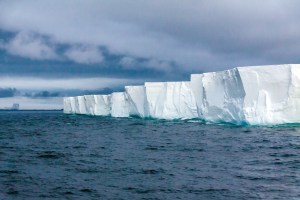West Antarctica: Ice sheet as tall as 137x Empire State Buildings lost in 25 years, says study PTI Updated: March 22nd, 2023, 19:24 IST in Sci-Tech 0 Pic- Wikimedia/Creative Commons Share on Facebook Share on Twitter Share on WhatsApp Share on Linkedin New Delhi: Scientists have calculated the ice lost from the Amundsen Sea Embayment, the fastest-changing Antarctic region and lying in West Antarctica, to be more than 3,000 billion tonnes over a 25-year period. The study by University of Leeds, UK, shows that West Antarctica saw a net decline of 3,331 billion tonnes of ice between 1996 and 2021, contributing over nine millimetres to global sea levels. The study said that if all of this lost ice was piled on London, it would stand over 2 km tall.
If it were to cover Manhattan, it would stand at as tall as 137 Empire State Buildings placed on top of one another. “Changes in ocean temperature and circulation appear to be driving the long-term, large-scale changes in West Antarctica ice sheet mass. We absolutely need to research those more because they are likely to control the overall sea level contribution from West Antarctica,” said Benjamin Davison, lead researcher of the study, University of Leeds.
The twenty major glaciers, which form the Amundsen Sea Embayment in West Antarctica, play a key role in contributing to the world’s oceans’ levels. They together are more than four times the size of the UK. If all the water held in the snow and ice were to drain into the sea, the study said, global sea levels could increase by more than one metre.
The findings are published in the journal Nature Communications. Davison calculated the “mass balance” of the Amundsen Sea Embayment, which describes the balance between mass of snow and ice gain from snowfall and mass lost through calving, where icebergs form at the end of a glacier and drift out to sea. The Embayment loses mass overall when the rate of calving is higher than that of ice being replaced by snowfall, thereby, contributing to global sea level rise.
Similarly, when snowfall supply drops, the Embayment can lose mass overall, again, contributing to sea level rise. “The 20 glaciers in West Antarctica have lost an awful lot of ice over the last quarter of a century and there is no sign that the process is going to reverse anytime soon although there were periods where the rate of mass loss did ease slightly,” said Davison. The scientists further found that several extreme snowfall events, that the Amundsen Sea Embayment had experienced over the 25-year study period, played a key role in the Embayment’s contribution to sea level rise during certain time periods.
This is because these events contributed up to half of the ice change at certain times. The researchers factored these extreme events of heavy snowfall and “snow drought” into their calculations. For example, between 2009 and 2013, the models revealed a period of persistently low snowfall, or “snow drought”.
The lack of nourishing snowfall starved the ice sheet and caused it to lose ice, therefore contributing about 25 per cent more to sea level rise than in years of average snowfall. In contrast, during the winters of 2019 and 2020 there was very heavy snowfall. The scientists estimated that this heavy snowfall mitigated the sea level contribution from the Amundsen Sea Embayment, reducing it to about half of what it would have been in an average year.
“We were really surprised to see just how much periods of extremely low or high snowfall could affect the ice sheet over two to five-year periods – so much so that we think they could play an important, albeit secondary role, in controlling rates of West Antarctic ice loss,” said Davison. “Scientists are monitoring what is happening in the Amundsen Sea Embayment because of the crucial role it plays in sea-level rise. If ocean levels were to rise significantly in future years, there are communities around the world who would experience extreme flooding,” said Davison.
PTI Tags: Antarctica global warming Ice melting ice sheet Share Tweet Send Share Suggest A Correction Enter your email to get our daily news in your inbox. Leave this field empty if you’re human: Related Posts India to cross $10 billion worth mobile exports in FY22-23, Apple leads at 50% March 22, 2023 PM Modi unveils 6G test bed, industry hails move March 22, 2023 EA to end three Battlefield games in April March 22, 2023 Microsoft introduces ‘Bing Image Creator’ powered by OpenAI’s DALL-E March 22, 2023 Google launches early access to its AI chatbot Bard March 22, 2023 WhatsApp’s new update gives admins more control over who can join group March 22, 2023 Leave a Reply Cancel reply Your email address will not be published. Required fields are marked * Comment * Name * Email * Website Save my name, email, and website in this browser for the next time I comment.
Δ.
From: orissapost
URL: https://www.orissapost.com/west-antarctica-ice-sheet-as-tall-as-137x-empire-state-buildings-lost-in-25-years-says-study/



